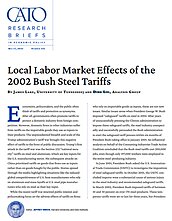Economists, policymakers, and the public often think of tariffs and protection as synonyms. After all, governments often promote tariffs to protect a domestic industry from foreign competition. However, domestic firms in other industries suffer from tariffs on the importable goods they use as inputs to their products. The unprecedented breadth and scale of the Trump administration’s tariff war brought this negative effect of tariffs to the front of public discussion. Trump’s first attack in the tariff war was the Section 232 “national security” tariffs on steel and aluminum, which are key inputs for the U.S. manufacturing sector. His subsequent attacks on China prioritized tariffs on goods that firms use as inputs rather than on goods bought by the public. Stories spread through the media highlighting situations like the reduced global competitiveness of U.S. boat manufacturers who rely on aluminum and mass layoffs at U.S. steel pipe manufacturers who rely on steel as their key input.
While the recent tariff war renewed public interest and policymaking focus on the adverse effects of tariffs on firms who rely on importable goods as inputs, these are not new issues. Similar issues arose when President George W. Bush imposed “safeguard” tariffs on steel in 2002. After years of unsuccessfully pressing the Clinton administration to impose these safeguard tariffs, the steel industry unexpectedly and successfully persuaded the Bush administration to start the safeguard tariff process within six months of President Bush taking office in January 2001. An influential analysis on behalf of the Consuming Industries Trade Action Coalition concluded that the Bush steel tariffs cost 200,000 jobs, even though only 197,000 workers were employed in the entire steel-producing industry.
In June 2001, President Bush asked the U.S. International Trade Commission (USITC) to investigate the imposition of steel safeguard tariffs. In October 2001, the USITC concluded imports were a substantial cause of serious injury to the steel industry and recommended safeguard tariffs. In March 2002, President Bush imposed tariffs of between 10 and 30 percent on over 170 steel products. These temporary tariffs were set to last for three years, but President Bush removed them in December 2003 after a November 2003 World Trade Organization (WTO) ruling against their WTO legality.
We analyze the impact of the Bush steel tariffs on employment in local U.S. labor markets in steel-consuming industries and the steel-producing industry. We construct measures for U.S. commuting zones (CZs)—geographic areas that delineate local economics—that reflect the protection they received for their steel-producing industry and their vulnerability based on their use of steel as an input in other industries. We account for various factors, including persistent differences between CZs, developments at the state and national levels, and changes in Chinese import competition. Our research design determines whether changes in CZ-level employment outcomes between the pre-and post-Bush steel tariff periods are related to differences in the local exposure of CZs to the Bush steel tariffs.
We have three main results. First, the Bush steel tariffs had large negative short-term effects on local steel-consuming employment but no notable positive effects on local employment in the steel industry. We define the steel-consuming industry two ways: the entire manufacturing sector or the most steel-intensive subset of industries within manufacturing. We find significant negative effects on steel-consuming employment once the Bush steel tariff process starts in 2001, especially in the highly steel-intensive industries, and these effects grew through 2002 and 2003. A change in CZ-level vulnerability to the Bush steel tariffs between the 25th and 75th percentile explains about 40 percent of the change between 2000 and 2003 in the share of the CZ’s working age population employed in manufacturing. The same change in CZ-level vulnerability explains around 100 percent of the change in the share of the CZ’s working age population employed in the most steel-intensive industries. Thus, our results emphasize the negative employment effects of tariffs in steel-consuming industries and downplay any potential positive effects for the steel-producing industry.
Our second main result is that the negative effects on steel-consuming employment are highly persistent. They remain stable until the end of our sample period in 2008— five years after the Bush steel tariffs ended in December 2003. This striking result is true for employment both in the overall manufacturing industry and in the most steel-intensive manufacturing industries.
Our third main result explores the mechanism behind these negative and persistent effects of the Bush steel tariffs on steel-consuming employment. We focus on two mechanisms: the inability of CZs to deal with negative trade shocks due to low education of their workforce and CZs’ degree of specialization in steel-consuming industries. First, we find an important role for education. CZs above and below the median share of the college-educated population experience similar negative impacts on steel-consuming employment during the Bush tariff years of 2001–2003. However, CZs above the median see these negative effects dissipate quickly, while CZs below the median see these persist for at least five years after the Bush steel tariffs end.
We find an even stronger role for the degree of steel-consuming industry specialization. CZs that are weakly specialized in steel-consuming industries, based on employment shares at the beginning of our sample in 1998, do not see any negative effects of the Bush steel tariffs on steel-consuming employment. Rather, CZs strongly specialized in steel-consuming industries drive all the large negative and persistent effects on employment. Ultimately, we find that the education level of the workforce and the degree of specialization in steel-consuming industries are important channels that affect the impact of steel tariffs on local labor markets.
NOTE
This research brief is based on James Lake and Ding Liu, “Local Labor Market Effects of the 2002 Bush Steel Tariffs,” CESifo Working Paper no. 9909, August 2022.

This work is licensed under a Creative Commons Attribution-NonCommercial-ShareAlike 4.0 International License.
